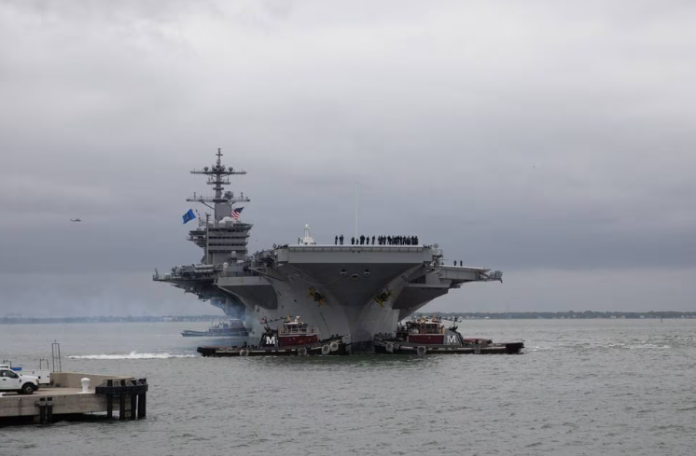WASHINGTON — With the aircraft carrier George Washington back at sea — albeit two years behind schedule — the U.S. Navy is combing through lessons learned from the delay in order to apply them to two other ships.
The ship’s midlife refueling and modernization effort was plagued by the pandemic, industrial base challenges, and unexpected repair work related to years worth of deployments. The Navy is now eyeing contractual changes and other reforms to both get another carrier, the John C. Stennis, out of its ongoing refueling as close to on time as possible and to benefit the next two carriers in line for their midlife work.
When the COVID-19 pandemic struck, the shipbuilder continued producing and repairing the Navy’s aircraft carriers and submarines; for the most part, delays most starkly affected the construction of new attack submarines.
But, “without a doubt, the COVID pandemic caused significant disruptions to the global supply chain that impacted material availability, impacted the workforce through required health protocols to aid in containing the spread of the virus, quarantine requirements, and a loss of senior skill sets through early retirement,” Naval Sea Systems Command spokesman Alan Baribeau told Defense News.
Meanwhile, the carrier Stennis is undergoing its refueling and complex overhaul now. The next in line are the Harry S. Truman, to begin in May 2025, and the Ronald Reagan, which is currently deployed to Japan and is expected to begin in 2029.
Stennis was delayed a couple months at the frontend, with refueling beginning in May 2021 instead of January to help minimize overlap with Washington. The Navy and HII plan RCOHs to happen more or less heel-to-toe, rather than with two taking place concurrently.
The 24-month overlap between Washington and Stennis split labor and material resources, therefore slowing the pace of work on Stennis, Baribeau said. The team also found unexpected but mandatory growth work in Stennis’ propulsion plant, further adding to the schedule.
‘Reduce the risk’
Even as the Navy and shipyard rework the schedule, they’re trying to pull lessons learned to inform Truman and Reagan.
Though growth work — or additional, unexpected repairs that arise once a maintenance period begins — is a fact of life with ship maintenance, Baribeau said several initiatives are aimed at minimizing the volume of growth work and its impact on the schedule.
One effort would expand the rotatable pool of parts to have more critical, long-lead material on hand — such as valves, generator-stacking kits, turbine generator rotors and shafts — based on data trends.
The team is also looking at a greater use of 3D scanning, in part to help document the difference between the condition of the ship as expected versus as-is upon arrival at Newport News so engineers can update the work packages to reflect any discrepancies.
On the contracting side, Baribeau said, the team is considering changes to how the Navy and industry share risks as a way to boost performance.
“The John C. Stennis RCOH has changed from cost-incurred payments to progress payments directly tied to schedule performance,” he said. “Additional efforts are underway to evaluate different contracting structures for the USS Harry S. Truman RCOH with deliverables targeted to understand and predict resource challenges within the entire Newport News Shipbuilding portfolio.”
Whereas stateside carriers have a three-year training, deployment and maintenance cycle that includes six months or more of planned maintenance at Norfolk Naval Shipyard in Virginia or Puget Sound Naval Shipyard in Washington, forward-deployed carriers undergo a much shorter stint each year in the maintenance yard in Yokosuka. This leads to some work being deferred.
Unlike Washington, which went straight from Japan into its refueling, Reagan will conduct a lengthy maintenance period, called a docked planned incremental availability, at Puget Sound between its return stateside and its RCOH set for 2029.
“This will provide an opportunity to have a better understanding of her material condition prior to entering RCOH, which will reduce the risk of unplanned growth work,” Baribeau said.
Ahead of Washington relieving Reagan in Japan next year, the former’s crew has been preparing since last summer to get to sea in their ship after six years in the yard — meaning thousands of sailors have cycled through the ship on orders and never spent a day at sea on the carrier.
Baribeau noted crew members have taken temporary assignments on other carriers to gain experience and earn qualifications, and rehearsed getting underway in simulators and in tabletop exercises.





